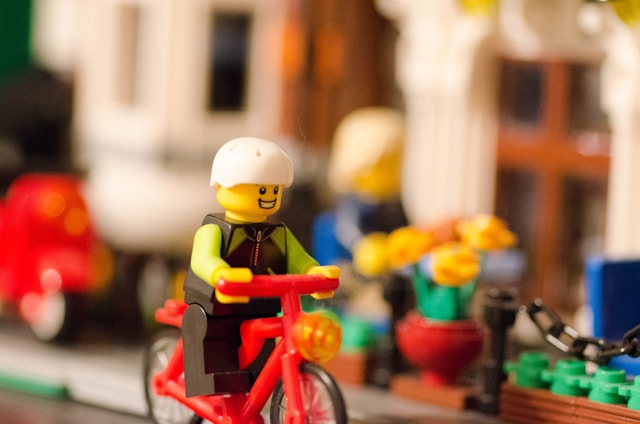Lego, the iconic brand known for its colorful interlocking bricks, has transcended its status as a mere toy company to become a cultural phenomenon. From humble beginnings in a small Danish workshop in 1932, Lego has grown into a multi-billion dollar enterprise with a global footprint. Central to this success is a masterful marketing strategy that has not only endured but evolved over the decades. For marketing professionals looking to glean insights from one of the world’s most beloved brands, Lego offers a lot of innovative practices and campaigns.
The Foundation: Core Brand Values
Lego’s marketing strategy is deeply rooted in its core values: imagination, creativity, fun, learning, caring, and quality. These values are not just slogans; they permeate every aspect of the company’s operations and marketing efforts. By consistently aligning its marketing messages with these values, Lego has built a strong emotional connection with its audience.
Example: The “Everything is Awesome” campaign from “The Lego Movie” epitomizes these values. The song and movie both celebrated creativity and imagination, reinforcing Lego’s brand promise in an engaging and entertaining way.
Understanding the Audience: Targeted Marketing
One of Lego’s key strengths lies in its deep understanding of its audience. The brand effectively segments its market into children, adults, and families, tailoring its messaging to each group.
Children: For children, Lego’s marketing focuses on play, creativity, and the joy of building. Commercials, digital content, and social media posts are designed to inspire and excite young builders.
Adults: Recognizing that adults are both buyers for children and enthusiasts themselves, Lego has created the “Adults Welcome” campaign. This initiative caters to the growing community of adult fans of Lego (AFOLs) with complex sets and sophisticated marketing.

Families: Family-focused marketing emphasizes the bonding experience of building together. Campaigns often highlight the educational benefits and the quality family time that Lego sets can facilitate.
Leveraging Nostalgia: Connecting Across Generations
Nostalgia is a powerful tool in Lego’s marketing arsenal. By tapping into the fond memories that many adults have of playing with Lego as children, the brand strengthens its appeal across generations.
Example: The “Rebuild the World” campaign launched in 2019 is a perfect example. It features a whimsical, imaginative world where anything is possible, resonating with both adults who remember their childhood play and children who are just discovering Lego.
Storytelling: Creating Engaging Narratives
Lego’s marketing is characterized by compelling storytelling. Whether through commercials, movies, or social media content, Lego creates narratives that captivate its audience.
Example: “The Lego Movie” franchise is a prime example of storytelling excellence. By creating an entire universe populated with Lego characters, the brand not only promoted its products but also entertained and engaged its audience on a deeper level.
Content Marketing: Expanding the Brand Universe
Lego has successfully expanded its brand universe through various content marketing initiatives. By creating engaging content that goes beyond traditional advertising, Lego keeps its audience engaged and invested in the brand.
Example: Lego’s YouTube channel, which boasts millions of subscribers, features a mix of content including animated series, building tutorials, and user-generated content. This strategy not only entertains but also provides value to its audience, fostering a loyal community.
Collaborations and Licensing: Expanding Reach
Collaborations and licensing agreements have been pivotal in extending Lego’s reach and relevance. By partnering with popular franchises and celebrities, Lego taps into new fan bases and keeps its product offerings fresh and exciting.
Example: The collaboration with “Star Wars” has been one of Lego’s most successful licensing deals. The Lego “Star Wars” sets have not only attracted fans of the franchise but also introduced Lego to a broader audience, boosting sales and brand visibility.

Digital Transformation: Embracing New Technologies
Lego has adeptly embraced digital transformation to stay relevant in the modern age. From augmented reality (AR) experiences to innovative digital platforms, Lego has integrated technology to enhance its products and marketing efforts.
Example: The Lego Life app is a safe social network for kids where they can share their creations, participate in challenges, and interact with the Lego community. This digital initiative not only engages young fans but also builds a sense of community and brand loyalty.
Social Media Mastery: Engaging the Digital Audience
Lego’s social media strategy is a masterclass in engagement. By creating content that is fun, informative, and shareable, Lego has built a strong social media presence across platforms like Instagram, Facebook, and Twitter.
Example: The #Buildtogether campaign on Instagram encourages fans to share their Lego creations using the hashtag. This user-generated content not only promotes engagement but also showcases the creativity of the Lego community, further enhancing the brand’s image.
Events and Experiences: Creating Memorable Moments
Lego understands the power of experiential marketing. By creating events and experiences that allow fans to interact with the brand in meaningful ways, Lego fosters deeper connections and lasting memories.
Example: The annual Lego conventions, such as Brickworld and BrickCon, offer fans the opportunity to meet fellow enthusiasts, participate in building competitions, and see impressive Lego displays. These events are not only fun but also reinforce the sense of community and passion that surrounds the brand.
Educational Initiatives: Adding Value Beyond Play
Lego’s commitment to education is a key component of its marketing strategy. By highlighting the educational benefits of its products, Lego adds value beyond mere play, appealing to parents and educators alike.
Example: The Lego Education line includes products and resources designed to teach STEM (Science, Technology, Engineering, and Mathematics) concepts. These products are marketed to schools and parents, emphasizing the developmental benefits of Lego play.
Sustainability: Aligning with Modern Values
In recent years, Lego has made significant strides in sustainability, aligning its brand with modern values and appealing to environmentally conscious consumers.
Example: The “Plants from Plants” initiative introduced Lego pieces made from sustainable materials. This move was promoted through various marketing channels, highlighting Lego’s commitment to environmental responsibility.
Crisis Management: Navigating Challenges
Lego’s ability to navigate challenges and crises is another testament to its robust marketing strategy. The brand has demonstrated resilience and adaptability in the face of adversity.
Example: During the COVID-19 pandemic, Lego swiftly adapted its marketing strategy to focus on online engagement and e-commerce. The “Let’s Build Together” campaign encouraged families to spend quality time building Lego sets at home, positioning the brand as a source of comfort and creativity during difficult times.
Community Engagement: Fostering a Loyal Fanbase
Lego’s emphasis on community engagement has helped build a loyal fanbase that actively promotes the brand. By creating platforms for fans to connect and share their passion, Lego fosters a sense of belonging and brand loyalty.
Example: The Lego Ideas platform allows fans to submit their own designs for potential production. This initiative not only engages the community but also generates innovative product ideas, further strengthening the brand’s connection with its fans.
Strategic Pricing: Offering Value at Every Level
Lego’s pricing strategy is designed to offer value at every level. By providing a range of products at different price points, Lego ensures that there is something for everyone, from budget-conscious parents to serious collectors.
Example: The introduction of smaller, more affordable sets alongside larger, more intricate ones allows Lego to cater to a wide audience without compromising on quality or brand perception.
Data-Driven Decisions: Leveraging Insights for Success
Lego’s marketing strategy is underpinned by data-driven decisions. By leveraging customer insights and market research, Lego tailors its marketing efforts to meet the needs and preferences of its audience.
Example: The use of customer feedback and sales data to inform product development and marketing campaigns ensures that Lego remains responsive to market trends and consumer demands.
Lessons from Lego’s Marketing Strategy
Lego’s marketing strategy is a blend of tradition and innovation, leveraging the brand’s rich heritage while embracing modern marketing practices. By staying true to its core values, understanding its audience, and continually evolving its approach, Lego has built a brand that resonates across generations and cultures.
For marketing professionals, Lego’s success offers valuable lessons in storytelling, audience segmentation, content marketing, and community engagement. By studying and emulating Lego’s strategies, marketers can craft campaigns that not only capture attention but also build lasting emotional connections with their audiences.
In a world where consumer preferences and market dynamics are constantly changing, Lego’s ability to remain relevant and beloved is a testament to the power of a well-executed marketing strategy. As Lego continues to build on its legacy, it serves as an inspiring example of how a brand can grow, adapt, and thrive through the power of marketing.
Lego’s enduring success offers valuable insights for marketers seeking to build strong, resilient brands. Here are five key lessons that can be gleaned from Lego’s marketing strategy:
1. Stay True to Core Values
Lego’s marketing is deeply rooted in its core values of imagination, creativity, fun, learning, caring, and quality. These values are consistently reflected in every campaign and product, ensuring a strong, cohesive brand identity that resonates with audiences of all ages.
Lesson: Establish and stay true to your brand’s core values. Consistency in messaging builds trust and loyalty among consumers. Make sure your marketing efforts align with these values to create a cohesive and compelling brand story.
2. Understand and Segment Your Audience
Lego excels at understanding and segmenting its audience. By targeting specific groups—children, adults, and families—Lego tailors its marketing strategies to meet the unique needs and desires of each segment. This targeted approach ensures that each audience feels seen and valued.
Lesson: Invest in market research to deeply understand your audience. Segment your market and tailor your messaging to each group’s specific interests and needs. Personalization fosters stronger connections and increases engagement.
3. Leverage Storytelling and Content Marketing
Lego’s use of storytelling, particularly through movies, TV shows, and digital content, has been pivotal in engaging its audience. The brand creates narratives that captivate and entertain, making its marketing not just promotional but also enjoyable and memorable.
Lesson: Utilize storytelling to make your marketing more engaging. Create content that goes beyond mere advertising—aim to entertain, inform, and inspire your audience. Storytelling can humanize your brand and foster a deeper emotional connection.
4. Innovate and Embrace Technology
Lego has embraced digital transformation through augmented reality apps, digital building experiences, and a robust online presence. By integrating technology into its products and marketing, Lego remains relevant and engaging in a digital-first world.
Lesson: Stay ahead of technological trends and incorporate them into your marketing strategy. Whether it’s through social media, apps, or digital content, leveraging technology can enhance your marketing efforts and keep your brand relevant.
5. Build and Engage a Community
Lego’s success is partly due to its strong community engagement. Platforms like Lego Ideas and events like Lego conventions create spaces for fans to connect, share, and contribute, fostering a loyal and passionate community.
Lesson: Create opportunities for your audience to engage with your brand and with each other. Encourage user-generated content, host events, and build platforms that facilitate interaction. A strong community not only promotes brand loyalty but also generates organic marketing through word-of-mouth.

